Walking Tours
Home Page
La Jolla
a walking tour by Carol Mendel
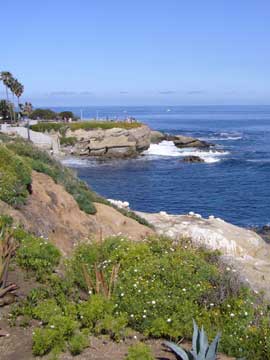
|
La Jolla occupies seven miles of curving coastline jutting out into the Pacific Ocean. Although officially a part of San Diego, it retains its own small-town atmosphere, its own civic pride, and its own La Jolla postmark. It is an elegant, exclusive shopping community, filled with boutiques, import shops, gourmet restaurants and stores that carry only the best. And it is a luxurious residential community, where beautiful homes, surrounded by lush subtropical plants, cover the hillsides overlooking the Pacific.
This self-guided walking tour, through the central area known as La Jolla Village, begins with the bluffs, coves, and rocky shoreline of La Jolla's spectacular, jagged coast. It then returns along Prospect Street, a paradise for elegant shopping, browsing, and dining.
Distance: One and half miles. Time: Allow one and a half to two hours for walking, plus plenty of extra time for stopping in shops and art galleries.
MAP of the walking tour
Terms of Use
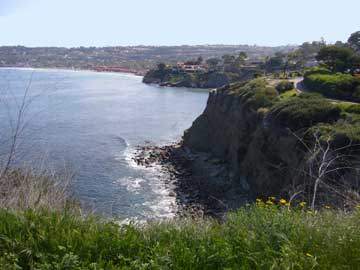
|
Follow the wide trail to the left, west, along the ridge of the bluff. The steep hillside is covered with sea-fig, a hardy groundcover native to South Africa. Commonly found along the Pacific Coast, it blooms in the spring with large, bright flowers. Watch the long swells of the Pacific Ocean glide toward the shore.

|
Among the trees is a wooden staircase leading down to a promontory with a viewing platform. Go down to the platform, and look back at the side of the bluff you have been walking along. Clearly visible on the sides of the bluff are sedimentary layers of rock and sandstone. Where the bluff meets the water, the surf has spent 200,000 years carving out caves.
It is a memorable experience to go inside one of these caves and look out from the inside. To do so, retrace your steps off the promontory and enter the Cave Store. Inside the store is the entrance to the 145 steps that lead down a lighted, man-made tunnel to the main chamber of Sunny Jim Cave. As you stand by the right-hand railing, looking out at the sky and ocean, the cave entrance will form the profile of a man with a pointed nose and a tuft of hair sticking up at the back of his head. This is "Sunny Jim," a cartoon character popular about a hundred years ago.
When you come out, continue your coastline walk. On your left, brown wood houses and shops blend into the hill and overlook the water. On your right you can see water rushing in and out of the cave it has dug under the promontory near where you were standing a few minutes ago.
A little farther along, on your left, is Brockton Villa, now used as a restaurant. It is one of the original cottages built in La Jolla around the turn of the 20th Century. The town of La Jolla was laid out and development began in 1887. By 1904 over 100 cottages dotted the landscape. By now, almost all of them have been demolished and replaced by modern apartments and condominiums.
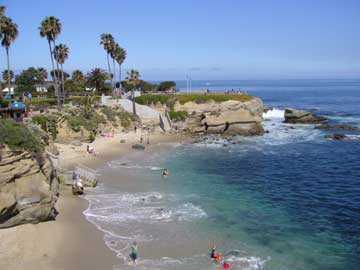
|
Beyond the beach of La Jolla Cove, the jutting piece of land is called Alligator Head. Thanks to a hundred years of pounding waves, it no longer looks like a resting 'gator. The crowning blow to the resemblance came in 1977, when a storm severed the arch that connected the alligator's snout to the rest of its body.
Beyond the cove, take the walkway along the ocean. On your right the surf rolls in over the shallow, rocky sea bottom, and crashes against the shore. When the tide is low, this is a popular place to explore the tide pools.
The park on your left is Ellen Browning Scripps Park, named for one of La Jolla's greatest admirers and most lavish benefactors. Ellen Browning Scripps spent her life as a teacher and journalist before coming to La Jolla in 1895, at the age of 59. Two years later she built a home on Prospect Street and lived here until she died in 1932.
During those years she bestowed innumerable gifts, including this park, on her adopted home. This walk will pass many of her major gifts, but not Scripps Institution of Oceanography, Scripps Memorial Hospital, or the Scripps Research medical research facility. Joining her in giving and endowing Scripps Institution of Oceanography was her brother, E. W. Scripps, founder of the Scripps-Howard newspapers and syndicate.
When you come out of the park, the monumental, 17-story, "939 Coast" condominium dominates your view. Totally out of proportion to the rest of the neighborhood, the building became the symbol of the fight between those who wanted La Jolla to retain its low-rise, low-density character, and those who wanted to replace the existing buildings with imposing high-rises. The uproar over the construction of this building in 1965 triggered a 50-foot height limitation on new construction. In 1972 the height limitation for construction along the San Diego coast was shortened from 50 feet to 30 feet.
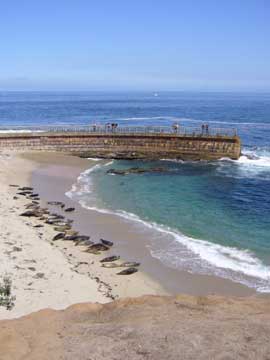
|
As you resume your walk along Coast Boulevard, you will see the tan walls, arched windows, and red tile roof of the Casa de Mañana across the street. Built in 1923, the Casa reigned for thirty years as one of La Jolla's most distinctive and prestigious hotels. Today it is run as a not-for-profit retirement community.
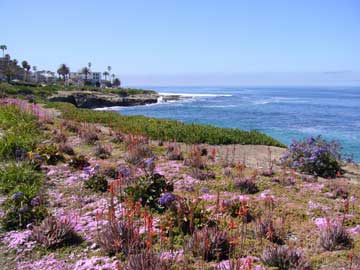
|
In one block you reach Prospect Street. Across the street and to the right is the campus of The Bishop's School, a private school for grades 7-12. Ellen Scripps made generous contributions to the Bishop's School.
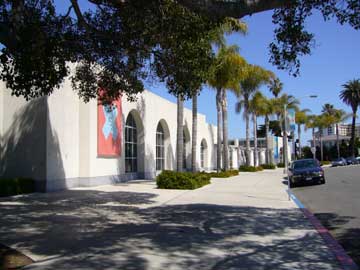
|
The building housing the art museum is a greatly remodeled form of a home built for Miss Scripps by architect Irving Gill. Gill built residences and public buildings in San Diego from the turn of the century until 1929, and has earned a national reputation for the simplified mission style he originated. Cross Prospect to see two excellent examples of this style -- the La Jolla Recreation Center and the La Jolla Woman's Club. Both were designed by Gill in 1914, and both were gifts from Miss Scripps. The style is one of extreme simplicity, and emphasizes plain walls, straight lines, and round arches.
A little farther along Prospect you will find a large dark-green cottage, now the home of the La Jolla Historical Society). This fine cottage was built in 1904 for Virginia Scripps, sister of Ellen Scripps.
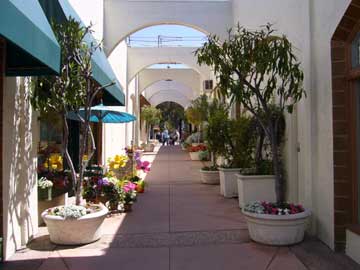
|
Cross Girard, and a few steps along Wall Street (yes, named for the one in New York City) will bring you to the entrance to the Athenaeum, a private music and arts library. The public is invited to use its collection of fine arts books, records, periodicals, sheet music, and scores in its reading rooms, but only members may check out materials.
Return to Girard Avenue, turn right, and turn right again when your reach Prospect Street. The next few blocks along Prospect, from Girard Avenue to Cave Street, are a shopper's and gourmet's delight. Both sides of the street are lined with art galleries and shops containing top-quality clothing, jewelry, and merchandise from all over the world. When your feet give out, you can stop for a snack or meal in one of Prospect's many foreign and domestic restaurants.
Return to top.
|
Enjoy this walking tour?
Check out the others in this series Balboa Park Cabrillo National Monument Downtown San Diego The Embarcadero La Jolla La Playa Mission Bay Park Mission Beach Old Town Shelter Island Sunset Cliffs |
Enjoy full-color illustrated maps? Check out the ones below. Some can be purchased as laminated maps, some as folded maps, some as wooden trays, and some as all three. San Diego Los Angeles Palm Springs Santa Barbara San Francisco Bay Area Las Vegas Salt Lake City Oregon Washington DC |